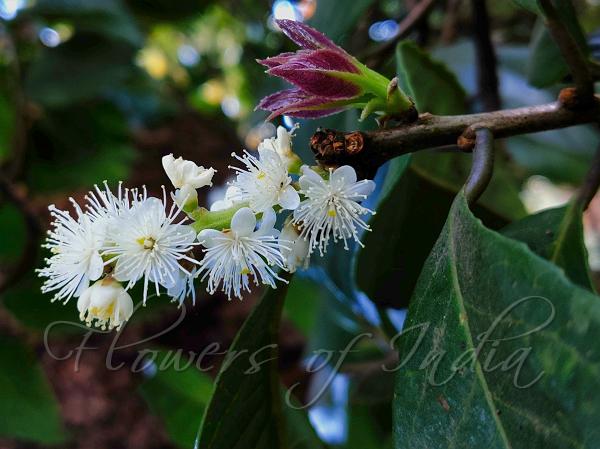|
| Lodh Tree |
|

|

| File size | 789553 |
| Original date | 12/26/20 7:57 AM |
| Resolution | x |
| Flash | Flash did not fire, auto |
| Focal length | 4.745mm |
| Exposure time | 1/33s |
| Aperture | 1.75 |
| Focus Distance | |
| Metering Mode | $meteringMode |
| Camera make | OnePlus |
| Camera model | GM1901 |
| Sensor type |
|
|
|
|
Photo: |
Botanical name: Symplocos racemosa Family: Symplocaceae (Saphire-berry family)
Synonyms: Lodhra racemosa, Symplocos hamiltoniana, Symplocos nicobarica
Synonyms: Lodhra racemosa, Symplocos hamiltoniana, Symplocos nicobarica
Lodh Tree is an evergreen medium-sized very beautiful
tree with a shady head growing up to a height of 6 10 meters. Bark,
greyish, warty; Leaves simple, alternate, 7-15 x 3-6 cm, elliptic or
elliptic-obovate, tip pointed to tapering, margin rounded
toothed-sawtoothed, hairless, shiny, leathery; leaf-stalk 6-15 mm long,
slender; lateral nerves 6-12 pairs. Flowers bisexual, in spikes, to 12
cm long; bracts ovate, falling off; Sepal-cup tube adnate to the ovary,
lobes 5, triangular, pointed, hairless. Flower deeply 5-lobed. Stamens
numerous, unequal, many seriate, adnate to the flower tube; Ovary
inferior. Fruit a drupe 15 x 5 mm, ovoid, shallowly furrowed, seeds
1-2, oblong. Lodh Tree is found in evergreen forests of the Western
Ghats and North-East India.
Medicinal uses: Bark powder of lodhra is an
important ingredient of Ayurveda skincare packs as it nourishes the
skin and gives benefits in acne, wrinkles, and other skin problems. The
bark of a tree has been traditionally used as a uterine tonic and in
the treatment of gynecological problems.
Bark powder of lodhra is an
important ingredient of Ayurveda skincare packs as it nourishes the
skin and gives benefits in acne, wrinkles, and other skin problems. The
bark of a tree has been traditionally used as a uterine tonic and in
the treatment of gynecological problems.
Medicinal uses:
 Bark powder of lodhra is an
important ingredient of Ayurveda skincare packs as it nourishes the
skin and gives benefits in acne, wrinkles, and other skin problems. The
bark of a tree has been traditionally used as a uterine tonic and in
the treatment of gynecological problems.
Bark powder of lodhra is an
important ingredient of Ayurveda skincare packs as it nourishes the
skin and gives benefits in acne, wrinkles, and other skin problems. The
bark of a tree has been traditionally used as a uterine tonic and in
the treatment of gynecological problems. | Identification credit: Jatin Vaity | Photographed at Harishchandrgad and Mahabaleshwar, Maharashtra. |
• Is this flower misidentified? If yes,